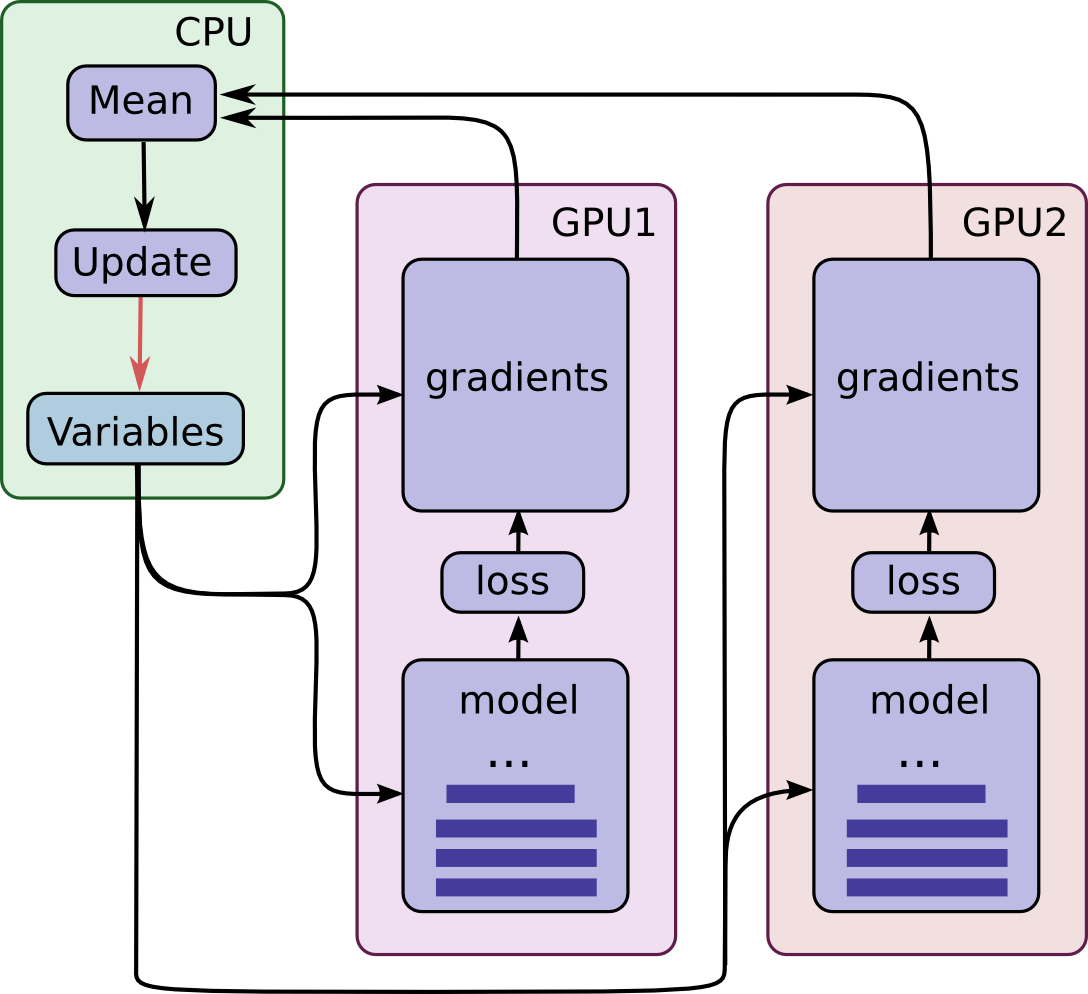How to make TensorFlow employ multiple GPUs
The content of this essay may not be true. It’s just a short note.
As far as I know, recent versions of TensorFlow do not automatically distribute work load to multiply GPUs, even the GPUs are visible to it.
If one want to make the multiple GPUs share the work load, he should distribute the work load to different GPUs manually. The distribution operation is called tower in some way.

Placing Variables and Operations on Devices
Placing operations and variables on devices requires some special abstractions.
The first abstraction we require is a function for computing inference and gradients for a single model replica. In the code we term this abstraction a “tower”.
ref: Advanced Convolutional Neural Networks | TensorFlow
example
# golbin/TensorFlow-Multi-GPUs: Samples for Multi GPUs in TensorFlow # https://github.com/golbin/TensorFlow-Multi-GPUs import datetime import tensorflow as tf from tensorflow.examples.tutorials.mnist import input_data from tensorflow.python.client import device_lib def check_available_gpus(): local_devices = device_lib.list_local_devices() gpu_names = [x.name for x in local_devices if x.device_type == 'GPU'] gpu_num = len(gpu_names) print('{0} GPUs are detected : {1}'.format(gpu_num, gpu_names)) return gpu_num def model(X, reuse=False): with tf.variable_scope('L1', reuse=reuse): L1 = tf.layers.conv2d(X, 64, [3, 3], reuse=reuse) L1 = tf.layers.max_pooling2d(L1, [2, 2], [2, 2]) L1 = tf.layers.dropout(L1, 0.7, True) with tf.variable_scope('L2', reuse=reuse): L2 = tf.layers.conv2d(L1, 128, [3, 3], reuse=reuse) L2 = tf.layers.max_pooling2d(L2, [2, 2], [2, 2]) L2 = tf.layers.dropout(L2, 0.7, True) with tf.variable_scope('L2-1', reuse=reuse): L2_1 = tf.layers.conv2d(L2, 128, [3, 3], reuse=reuse) L2_1 = tf.layers.max_pooling2d(L2_1, [2, 2], [2, 2]) L2_1 = tf.layers.dropout(L2_1, 0.7, True) with tf.variable_scope('L3', reuse=reuse): L3 = tf.contrib.layers.flatten(L2_1) L3 = tf.layers.dense(L3, 1024, activation=tf.nn.relu) L3 = tf.layers.dropout(L3, 0.5, True) with tf.variable_scope('L4', reuse=reuse): L4 = tf.layers.dense(L3, 256, activation=tf.nn.relu) with tf.variable_scope('LF', reuse=reuse): LF = tf.layers.dense(L4, 10, activation=None) return LF if __name__ == '__main__': # need to change learning rates and batch size by number of GPU batch_size = 20000 learning_rate = 0.001 total_epoch = 1000 gpu_num = check_available_gpus() X = tf.placeholder(tf.float32, [None, 28, 28, 1]) Y = tf.placeholder(tf.float32, [None, 10]) losses = [] X_A = tf.split(X, int(gpu_num)) Y_A = tf.split(Y, int(gpu_num)) ''' Multi GPUs Usage Results on P40 * Single GPU computation time: 0:00:22.252533 * 2 GPU computation time: 0:00:12.632623 * 4 GPU computation time: 0:00:11.083071 * 8 GPU computation time: 0:00:11.990167 Need to change batch size and learning rates for training more efficiently Reference: https://research.fb.com/wp-content/uploads/2017/06/imagenet1kin1h5.pdf ''' for gpu_id in range(int(gpu_num)): with tf.device(tf.DeviceSpec(device_type="GPU", device_index=gpu_id)): print(f'***1111** tf.get_variable_scope *********** {tf.get_variable_scope()}') with tf.variable_scope('kkkkk', reuse=(gpu_id > 0)): # with tf.variable_scope(tf.get_variable_scope(), reuse=(gpu_id > 0)): """ The usage of previous line is reusing the variables within different GPUs. This is relatively easy to understand. But the usage of the `tf.variable_scope()` statement for the `name` of the `tf.variable_scope` may be confusing to someone not familiar with this. The purpose of previous line is keep the `tf.variable_scope()` be same to the recent environment, while making share variables with different groups of operations, meaning it makes `variable` reusing with different groups of operations without wrapping each group into a new wrapper. To make it more clear, you could make use of `tensorboard` to visualize the `graph`s of different conditions, which will make the differences obvious. """ print(f'**2222*** tf.get_variable_scope *********** {tf.get_variable_scope()}') cost = tf.nn.softmax_cross_entropy_with_logits( logits=model(X_A[gpu_id], gpu_id > 0), labels=Y_A[gpu_id]) losses.append(cost) loss = tf.reduce_mean(tf.concat(losses, axis=0)) optimizer = tf.train.AdamOptimizer(learning_rate).minimize( loss, colocate_gradients_with_ops=True) # Important! init = tf.global_variables_initializer() writer = tf.summary.FileWriter('logs') sess = tf.Session(config=tf.ConfigProto(log_device_placement=False)) sess.run(init) writer.add_graph(graph=sess.graph) writer.flush() mnist = input_data.read_data_sets('/tmp/tensorflow/mnist/input_data', one_hot=True) total_batch = int(mnist.train.num_examples / batch_size) print("total: %s, %s, %s" % (mnist.train.num_examples, total_batch, batch_size)) start_time = datetime.datetime.now() for epoch in range(total_epoch): total_cost = 0 for i in range(total_batch): batch_xs, batch_ys = mnist.train.next_batch(batch_size) batch_xs = batch_xs.reshape(-1, 28, 28, 1) _, cost_val = sess.run([optimizer, loss], feed_dict={X: batch_xs, Y: batch_ys}) total_cost += cost_val print("total cost : %s" % total_cost) print("--- Training time : {0} seconds /w {1} GPUs ---".format( datetime.datetime.now() - start_time, gpu_num))
example repo
golbin/TensorFlow-Multi-GPUs: Samples for Multi GPUs in TensorFlow
https://github.com/golbin/TensorFlow-Multi-GPUs
models/tutorials/image/cifar10 at master · tensorflow/models
https://github.com/tensorflow/models/tree/master/tutorials/image/cifar10/





【推荐】国内首个AI IDE,深度理解中文开发场景,立即下载体验Trae
【推荐】编程新体验,更懂你的AI,立即体验豆包MarsCode编程助手
【推荐】抖音旗下AI助手豆包,你的智能百科全书,全免费不限次数
【推荐】轻量又高性能的 SSH 工具 IShell:AI 加持,快人一步
· 开发者必知的日志记录最佳实践
· SQL Server 2025 AI相关能力初探
· Linux系列:如何用 C#调用 C方法造成内存泄露
· AI与.NET技术实操系列(二):开始使用ML.NET
· 记一次.NET内存居高不下排查解决与启示
· 阿里最新开源QwQ-32B,效果媲美deepseek-r1满血版,部署成本又又又降低了!
· 开源Multi-agent AI智能体框架aevatar.ai,欢迎大家贡献代码
· Manus重磅发布:全球首款通用AI代理技术深度解析与实战指南
· 被坑几百块钱后,我竟然真的恢复了删除的微信聊天记录!
· AI技术革命,工作效率10个最佳AI工具